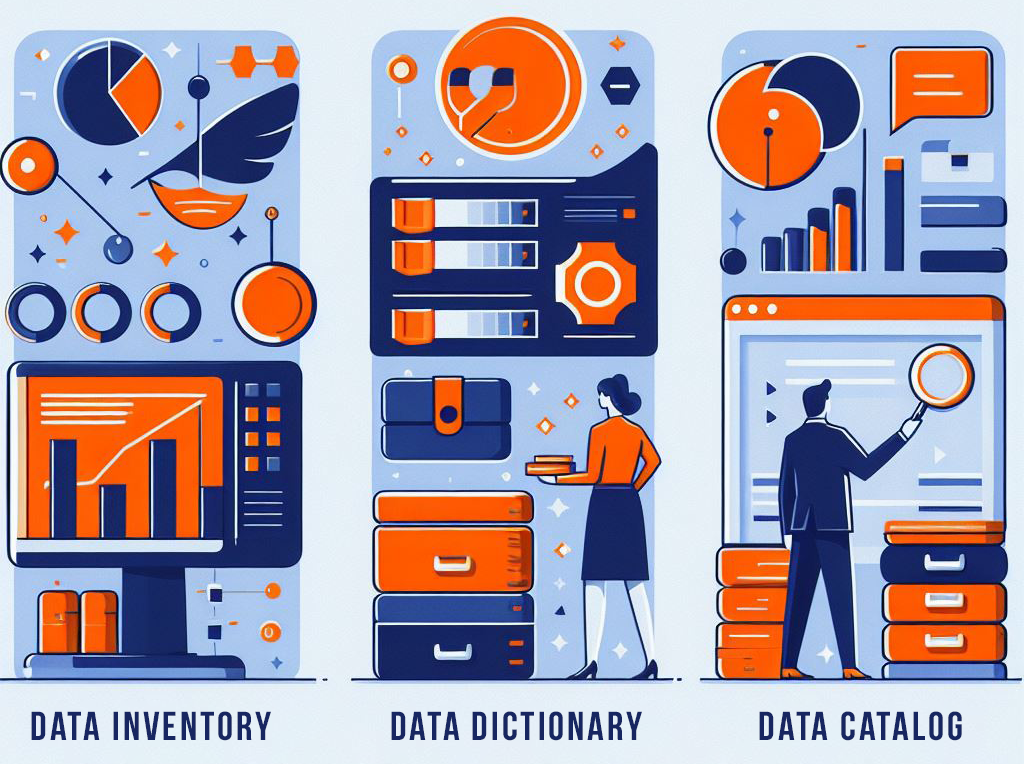
Data Dictionary vs. Data Inventory vs. Data Catalog

To manage a lot of information effectively, it’s important to understand the tools and concepts used in data management. Three key terms that often come up in this context are data dictionary, data inventory, and data catalog.
While these terms are sometimes used interchangeably, they actually refer to distinct aspects of data management. This guide will explain what definitions, purposes, and examples are. This will also show how they work together to create a strong data management framework.
Data Dictionaries
A data dictionary, also known as a metadata repository, is a central resource. It provides detailed information about the structure, format, and meaning of data elements. This information is for a database or information system.
This guide is for developers, database administrators, and other technical stakeholders. They need to understand the complexities of a database.
A data dictionary helps make sure that data is defined and used consistently and clearly throughout an organization.
By providing a single source of truth for data definitions, it helps prevent ambiguity, misinterpretation, and duplication of effort. Data dictionaries typically include information such as:
- Table and column names
- Data types and lengths
- Constraints and default values
- Relationships between tables
- Business rules and definitions
Example of a Data Dictionary
Let’s consider a retail company that maintains a product database. The data dictionary for this database would include entries like:
- Table: Products
- Column: ProductID (Integer, Primary Key)
- Column: ProductName (String, Max Length 100)
- Column: Category (String, Max Length 50)
- Column: Price (Decimal, Precision 10, Scale 2)
- Column: QuantityInStock (Integer)
This data dictionary provides a clear and concise description of the structure and format of the Products table, making it easier for developers and analysts to work with the data.
Benefits of a Data Dictionary
Having a well-maintained data dictionary offers several benefits to an organization, including:
- Better data quality: A data dictionary helps keep data accurate and reliable by making sure to consistently define and format it.
- Efficiency is to improve by having a central source for data definitions. This allows developers and analysts to easily understand the database structure. As a result, time and effort are saved when working with the data.
- Enhanced collaboration: A data dictionary facilitates communication and collaboration among team members by providing a common language and understanding of the data.
- A data dictionary makes it easier to maintain databases by tracking and managing changes to the data structure. This reduces the risk of errors and inconsistencies as databases evolve.
Data Inventories
A data dictionary describes the structure and meaning of data in a database. A data inventory examines all of an organization’s data assets.
An inventory is a list of all data assets in an organization. This includes databases, spreadsheets, reports, and other data sources.
The primary purpose of a data inventory is to provide a high-level overview of an organization’s data landscape. It helps answer questions like:
- What data assets do we have?
- Where are they stored?
- Who owns and maintains each asset?
- How is the data being used?
- What is the quality and completeness of the data?
By creating a data inventory, organizations can better understand the breadth and depth of their data assets, identify gaps and redundancies, and make informed decisions about data management and governance.
Example of a Data Inventory
Let’s say a manufacturing company wants to create a data inventory. They would start by identifying all the data assets across their organization, such as:
- Enterprise Resource Planning (ERP) system
- Customer Relationship Management (CRM) database
- Supply chain management system
- Quality control databases
- Sales and marketing spreadsheets
For each data asset, the inventory would capture key metadata, including:
- Data owner and steward
- Storage location and format
- Update frequency and data freshness
- Access permissions and security controls
- Data quality and completeness metrics
Consequently, This information helps the organization understand the state of their assets, identify areas for improvement, and ensure compliance with data governance policies and regulations.
Benefits of a Data Inventory
Maintaining a comprehensive data inventory offers several benefits, including:
- Better data management is achieved through a data inventory. This inventory helps organizations keep track of their assets. It ensures that data is being used correctly, according to rules and laws.
- Enhanced data security: A data inventory helps identify sensitive and confidential data, enabling organizations to implement appropriate security controls and access permissions.
- Increased efficiency: With a centralized repository of assets, organizations can reduce duplication of effort and streamline data management processes.
- Better decision-making: By understanding the full scope of their assets, organizations can make more informed decisions about data investments, prioritization, and resource allocation.
Discovering Data Catalogs
A data catalog is a convenient and easy-to-use database of an organization’s data assets. It serves as a central hub for finding, comprehending, and retrieving data.
It improves data inventory by including detailed information like metadata, data lineage, and data quality. This helps users easily find and trust the data they need.
The primary purpose of a data catalog is to democratize data access and enable self-service analytics.
A data catalog helps people in business, analysts, and data scientists find and explore data on their own. They can do this without assistance from IT or data management teams.
Key features of a data catalog include:
- Search and discovery: Users can easily find data assets across the organization by searching with keywords, tags, and filters.
- A data catalog is a tool used for managing metadata. Metadata includes detailed information about each data asset. This information can include descriptions, data lineage, data quality scores, and user ratings and comments.
- Users can view a small sample of the data and statistics for each asset before accessing the full data. This allows them to understand the data before using it. This helps them get an idea of what the data is like before they start using it.
- Data lineage is tracked by a data catalog. The data catalog shows how data moves from source to destination. It also shows how data is transformed and used within the organization.
- Users can work together on data assets by leaving comments, ratings, and annotations. They can also share data assets with others using the catalog.
Example of a Data Catalog
Consider a healthcare organization that has implemented a data catalog. A data scientist looking for patient data related to a specific condition can search the catalog using relevant keywords.
The search results would include datasets from various sources, such as electronic health records, clinical trials, and claims databases.
For each dataset, the catalog would provide a description of the data, including the format, schema, and data quality metrics.
Data scientists can review a small portion of the data to make sure it fits their requirements. They can also look at how the data was collected, changed, and used in various analyses over time.
The data scientist can find the right datasets. They can get the data from the catalog or work with data owners to ask for access. They need to make sure they follow data rules.
Benefits of a Data Catalog
Implementing a data catalog offers several benefits to organizations, including:
- A data catalog helps users find and understand data in one place. It stores all data assets in the organization. This makes it easier for users to access the information they need.
- Data governance is improved by using a data catalog. The catalog clearly lists all data assets, their owners, and access permissions. This helps in enforcing policies more effectively.
- A data catalog helps users share, comment on, and rate data assets. This promotes collaboration and knowledge sharing within the organization. Improved teamwork is a result of using a data catalog.
- A data catalog makes it easier for users to find and use the data they need. This speeds up the process of getting insights and making decisions based on data.
Putting It All Together
While data dictionary, data inventory, and data catalog serve distinct purposes, they are interconnected and work together to create a comprehensive data management framework.
Data dictionaries provide the foundation by defining the structure and meaning of data elements within specific databases.
Data inventories list all data assets in an organization, giving an overview of the data landscape.
Finally, Data catalogs make it easier for many people to find, understand, and use these assets.
To effectively implement these tools, organizations should follow best practices such as:
- Defining clear ownership and governance policies for data assets
- Establishing standardized metadata and data quality metrics
- Implementing automated data discovery and cataloging processes
- Integrating data catalogs with other data management tools, such as data lineage and data governance platforms
- Providing training and support to help users adopt and leverage these tools effectively
Real-World Examples
Many organizations across industries have successfully implemented data dictionary, inventory, and catalog to improve their data management practices.
Here are a few additional examples:
- Uber uses a data catalog to help data scientists and analysts find and access data from various sources. These sources include rider and driver databases, geospatial data, and machine learning models.
- Unilever, a big company that makes products for consumers, now has a global data catalog. This helps them see all their data in one place, no matter which brand, region, or business unit it comes from. This has enabled greater data sharing, collaboration, and innovation across the organization.
- The World Bank: The international financial institution has created a data catalog to make its vast collection of development data more accessible and understandable to researchers, policymakers, and the public. The catalog includes metadata, data previews, and interactive visualizations, making it easy for users to explore and use the data.
Conclusion
Data dictionary, data inventory, and data catalog are essential tools for managing the complex data landscapes of modern organizations.
These tools help organizations understand their data assets, how they are structured, and how they are related. This allows for better data quality, governance, and access for everyone.
As the volume and variety of data continue to grow, the importance of these tools will only increase.
Companies that focus on creating and maintaining detailed data dictionaries, inventories, and catalogs will have a strategic advantage. This advantage will help them utilize their data assets for a competitive edge and make informed decisions based on data.
By following best practices and leveraging the latest technologies, organizations can create a robust data management framework that empowers users, ensures data quality and security, and enables the full potential of data-driven insights.
Organizations can use the right tools and processes to turn their data assets into a strategic advantage. This can help drive innovation and growth in the digital age.
